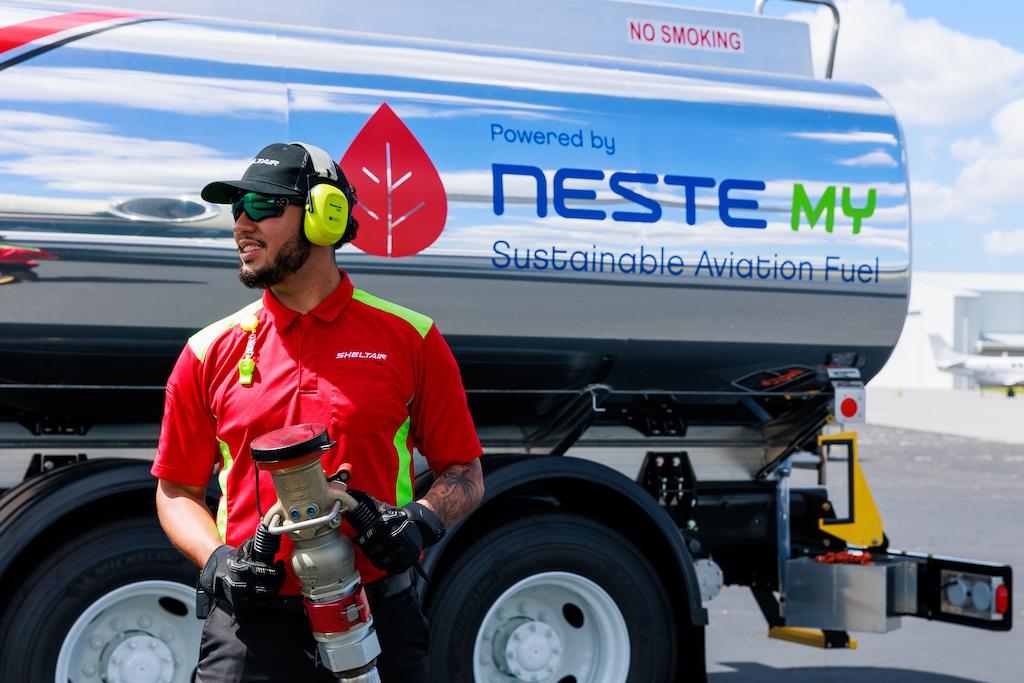
There is consensus that sustainable aviation fuel (SAF) is the linchpin for aviation to achieve net-zero carbon emissions by 2050; the focus now is shifting to making SAF itself sustainable. The industry’s emphasis is changing from “sustainability” to “scalability.”
Scalability will only be achieved, fuel developers and suppliers say, by building the refineries needed to produce SAF at scale and changing the mix of sustainable feedstocks used to mine carbon from fats, oils and greases to biomass, municipal waste and other sources.
“Used cooking oil isn’t made [for] SAF; it’s a residual of cooking oil,” explains Alder Fuels President and CEO Bryan Sherbacow. “The fats and greases that are used are byproducts of the protein market—steak, chicken, pork and whatnot—that is being produced. There’s only so much demand for that and it grows at about 2% annually. That’s not enough to displace the amount of oil that we need in the world.”
The ambition of sustainability exceeds the spigot available for SAF. Member states of the International Civil Aviation Organization (ICAO) adopted the “aspirational goal” of net-zero carbon emissions at the 41st ICAO Assembly in October, naming new aircraft technologies, streamlined flight operations and increased SAF production as the steps necessary for success. Waypoint 2050, a report issued by an international air transport industry coalition in 2021, estimated that using SAF in turbine engines will yield 53-71% of aviation decarbonization.
Aviation in the U.S. consumed 23 billion gal. of jet fuel in 2019 before the Covid-19 pandemic curbed demand; last year, approximately 5 million gal. of SAF were produced domestically, according to the U.S. government. In September 2022, federal agencies released a SAF Grand Challenge Roadmap that lays out a strategy for supplying at least 3 billion gal. of SAF per year by 2030 and enough SAF to meet 100% of aviation fuel demand—projected to be 35 billion gal.—by 2050.
With less than eight years left, the path to meeting the 2030 goal requires an immediate focus on commercially ready conversion technologies and feedstocks, the roadmap advises. Lipid-based pathways using fats, oils and greases are expected to be the primary fuel pathway leading up to 2030, with a smaller contribution from municipal waste, forest and agricultural residue and alcohol pathways during that period.
“Going from 5 million to 3 billion gal./yr by 2030 is a 600-fold increase that requires a 122% year-over-year growth in production to 2030,” the roadmap states. “It is critical this growth starts immediately. …At the same time and in parallel, the foundation must be set to achieve the longer-term 2050 goal. More than 400 biorefineries and 1 billion tons of biomass and/or gaseous carbon oxide feedstock will be needed to produce 35 billion gal./yr by 2050.”
Executives Expect Increased Demand

On the demand side, research commissioned by Airbus Corporate Jets (ACJ) finds that 58% of 100 senior U.S. executives surveyed expect that SAF use in private aviation will increase “significantly” over the next five years, with a further 32% forecasting at least a “slight increase.” Eighty-nine percent of the executives believe the cost of sustainably sourced jet fuel will decline as investments are made in technologies to process feedstocks more efficiently and at greater scale. Pureprofile, an independent research company, conducted the study for ACJ in September.
Fixed-base operators (FBO) serving business aviation started offering SAF, initially on a demonstration basis, in late 2020. As of October, sustainability rating firm 4AIR counted 24 FBOs in the U.S. that supply SAF and 38 overall when including international locations. In addition to locations in California, FBOs also offer SAF in Colorado, Michigan, North Carolina, Oregon, Texas and Washington.
At the NBAA-BACE conference in mid-October, Signature Flight Support said it will expand the availability of Neste MY Sustainable Aviation Fuel to all 10 of its locations in California. Signature, the largest FBO network, now pumps SAF at 17 locations. While Neste is its largest SAF supplier, Signature also buys SAF from World Energy and BP. Neste refines SAF in Houston and sources much of the feedstock in North America, says Lana Van Marter, Neste U.S. commercial development manager for renewable aviation.
In Part 2 of this article, we will take a look at the current distribution of SAF in the U.S.





